The human body is constantly exposed to external dangers. This is a different type of disease, infection, etc. One of the most common serious problems is parasites. They enter the body completely unnoticed, the consequences can be very serious. It is important to know which parasites of the human body are the most dangerous, what are the health threats that are due to them. You can see the parasites in detail in the photo.
Different worms live all over the world, they are all divided according to the mode of transmission, type. Parasitic worms are transmitted to humans mainly in the following ways:
- infected person;
- animals;
- soil, food, water;
- insect bites.
Worms are divided into several types:
- trematodes;
- round;
- tape.
Worms are a very large class of parasitic worms that live in plants, animals, and humans. They can live in hollow organs, thicker tissues, the tissues themselves.
The 10 most dangerous parasites in the human body
- Schistosomes are dangerous parasites of tropical waters.
- Rishta is a worm that lives under human skin.
- Filariae are dangerous parasites of elephantiasis.
- Echinococci are dangerous larvae in the body.
- Moustached Vandellia is a parasite of fish.
- Roundworms are known to all worms.
- The bovine tapeworm is a very large and long worm.
- Ankylostoma is a harmful little worm.
- Broad tapeworm: danger to human intestines.
- The pork tapeworm is a dangerous disease.
Schistosomes: live in venous blood
The parasite's second name is blood fluke. The infection occurs through the skin, contact with contaminated water. The disease caused by schistosomiasis is called schistosomiasis.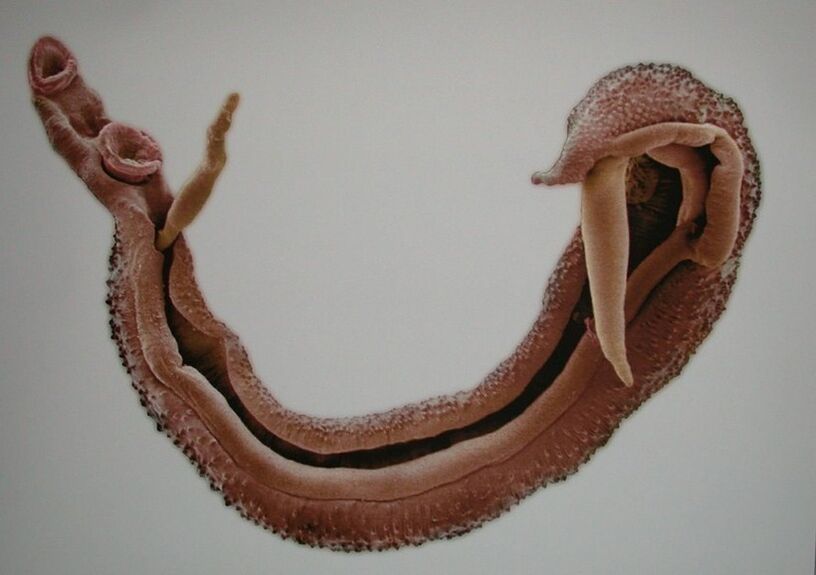 They differ from other helminths in their habitat: they live and multiply in the venous system. Most common in South America, Africa, the Middle East, Southeast Asia. They are not oversized, length 2. 6cm, diameter 0. 6mm, which is clearly visible in the photo. A person becomes infected with the following symptoms:
They differ from other helminths in their habitat: they live and multiply in the venous system. Most common in South America, Africa, the Middle East, Southeast Asia. They are not oversized, length 2. 6cm, diameter 0. 6mm, which is clearly visible in the photo. A person becomes infected with the following symptoms:
- intestinal disorder;
- enlarged lymph nodes, spleen.
But the symptoms are different, it all depends on where in the body the schistosomes have accumulated:
- nervous system: disorientation, memory loss, headache;
- bladder: organ inflammation, blood in urine, abdominal pain;
- liver - ascites, organ enlargement, spleen;
- intestines - diarrhea, polyps.
Worm eggs are very dangerous, they pierce, damage the walls of the lymphatic and blood vessels of various organs and tissues. In this way, parasites can even enter the uterus, lungs, prostate, and stomach. Worms, eggs clog blood vessels, which leads to the formation of varicose veins, tumors, cysts. Helminths of this type can cause serious problems, such as bladder, liver, prostate cancer, and liver fibrosis. To avoid infection with the most dangerous parasites of the human body, it is very important to avoid swimming in tropical waters, wash vegetables, fruits and hands well before eating. Schistosomiasis can be cured conservatively if treatment is started early. In case of complications, operations are performed.
Rishta - subcutaneous worm
Guinea worm is a disease caused by this type of parasite in the human body. The infection occurs through dirty water from tropical reservoirs in Asia and Africa. Humans are usually infected, but there are cases of infected dogs.

The worm enters the human body by swallowing contaminated water, where copepods, which carry rishta larvae, live. Treatment only by surgery. Secondary infection of already injured skin is very dangerous.
Once in the body, the rishta literally gnaws at the tissues, the intestinal walls, lives in the lymphatic vessels, the subcutaneous fat. In length, the worm can grow up to 80 centimeters. Strong abscesses appear in the areas of the body where the rishta are found, and parasites can be found within them. The disease is caused only by females, males die after mating. When an area of infected skin comes into contact with water, the female worm comes out a short distance and sheds her larvae into the water. These larvae must be captured by copepod crabs to survive.
Filariae are a very dangerous parasite for the body
Another name for the worm is filamentous. Of all the species, about 10 prefer people, they lead to filariasis. They were called thread because of their appearance, the worms are very thin, like a thread, this can be seen in the photo. 0. 3 cm in diameter, however, they grow large in length, up to 50 cm or more. Having hit the body, they live in the subcutaneous tissue, the body cavity, the heart, the blood, the lymphatic vessels, any part of the body. Very common in hot countries.
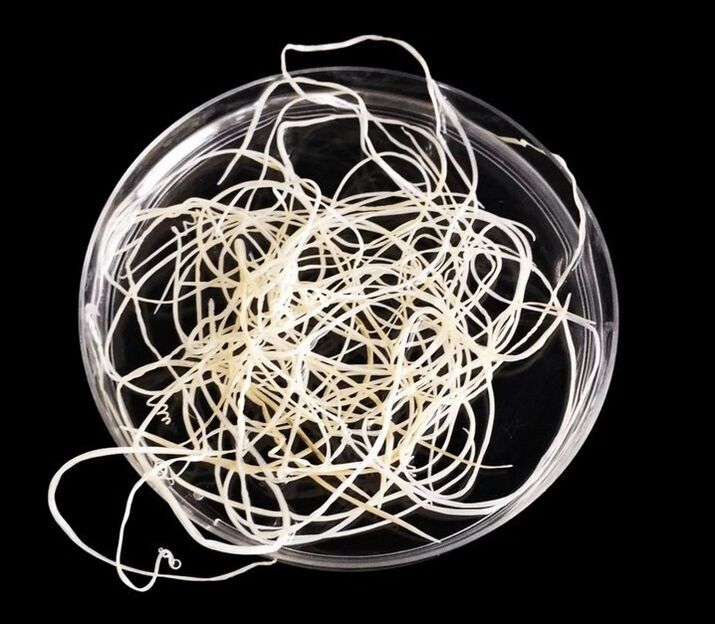
They are transmitted through blood-sucking insects, sometimes ticks, which in turn become infected through the blood of an infected animal, a human. The danger lies in the fact that the most terrible worms can be detected when the ailment has become chronic, it is almost impossible to cure it. By accumulating, filariae block the lymphatic system, clog blood vessels, causing elephantiasis. The patient's legs are enlarged, excessively swollen, up to the impossibility of moving, there are many photos of people with this disease on the Internet.
Echinococcus is a great danger to humans and animals
This tapeworm lives in the intestines of dogs, wolves, rarely cats, and can be easily transmitted to humans.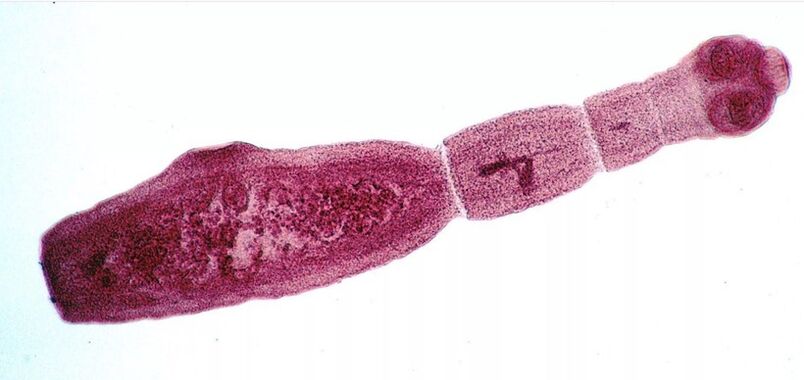 Echinococcus larvae are one of the most dangerous and cause echinococcosis. An adult worm is 3 to 5 mm long, in the photo that describes the parasite it is clearly seen that it has a head with suction cups, hooks and segments. From the body of canines, the eggs come out with the feces and are sometimes stained with wool.
Echinococcus larvae are one of the most dangerous and cause echinococcosis. An adult worm is 3 to 5 mm long, in the photo that describes the parasite it is clearly seen that it has a head with suction cups, hooks and segments. From the body of canines, the eggs come out with the feces and are sometimes stained with wool.
Infection is also possible through livestock. The infection occurs in humans through the mouth, eating contaminated meat, dog saliva. The larvae penetrate further into the body, through the blood they enter the liver, where they live and multiply. It rarely gets into bones, muscles, lungs. As they develop, echinococci grow into large bubbles the size of a child's head. Depending on the neglect of the disease, treatment is carried out with drugs or immediately, removing the tissues of the organ along with the bubbles of the larvae.
Mustachioed Vandellia: the smallest and most terrible
In general, this creature belongs to fish, but it is one of the most dangerous for the body. People are afraid of it because during the bath, a small almost transparent creature 15 cm long can easily penetrate the urethra, genitals and anus. Then Vandellia attaches itself to the vessels and feeds on blood. Unfortunately, the only way to get rid of the parasite is through surgery.
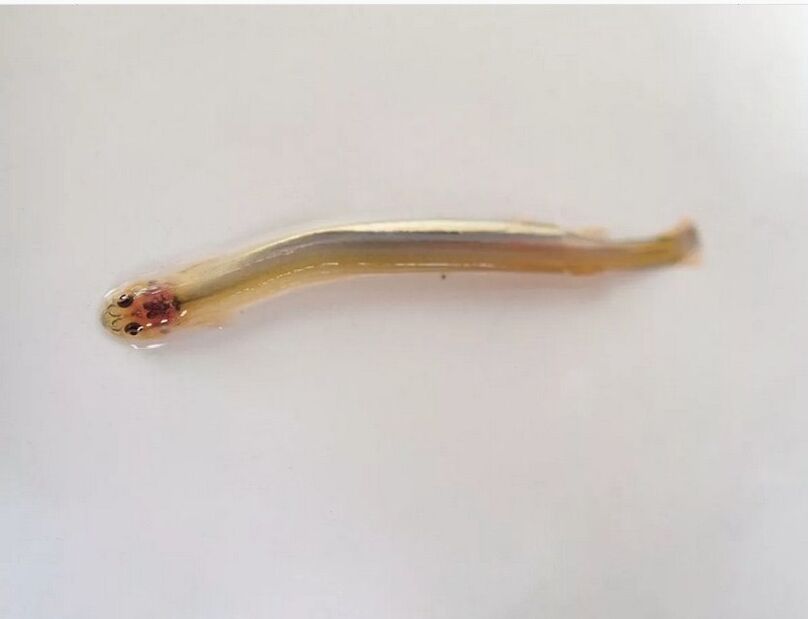
Ascaris: the most famous worm in the human body
The parasite is widespread and often found in the human body. If the eggs of a human roundworm fall to the ground, they can be stored there for almost a year until they are moved to a favorable environment. In the body, it releases toxins that affect the liver and lungs. Ascaris does not stop in one place, it constantly travels through the body, affects blood vessels and causes inflammation.
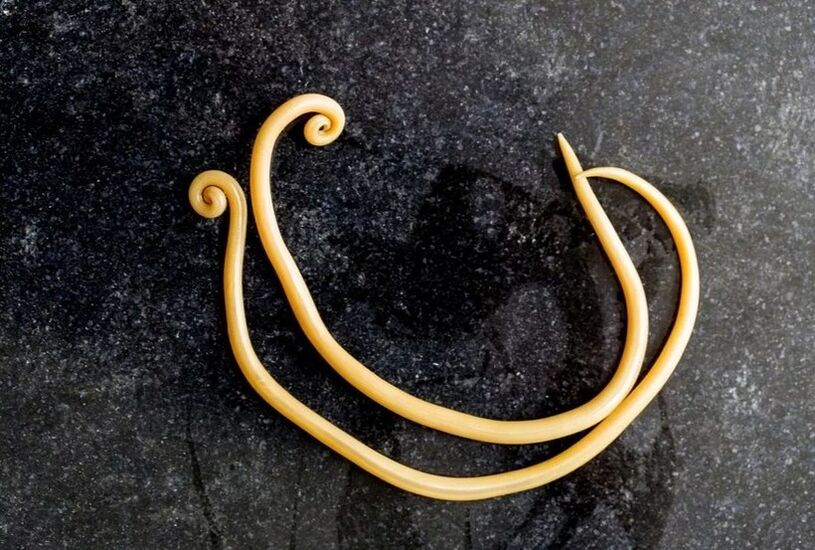
The main place of life of the most harmful worm is the intestine, where the parasites live comfortably, eating the food that the infected person ingests. They can pass into the pancreas, bile, liver, reach the esophagus and block breathing. A roundworm lays up to 1, 000 eggs per day. They grow quite large in length, up to 30 cm.
The bull tapeworm is the largest and most dangerous worm
This very large parasite lives in the small intestine, the photos of the tapeworm are just amazing. The body of the tapeworm consists of a head with suckers, a large number of segments, numbering from 2000 to 5000. The length of the worm constantly increases with growth, up to 10 meters. In the human body, without treatment, it can live up to 20 years. It produces around 600 million eggs per year, up to 11 billion per life cycle.
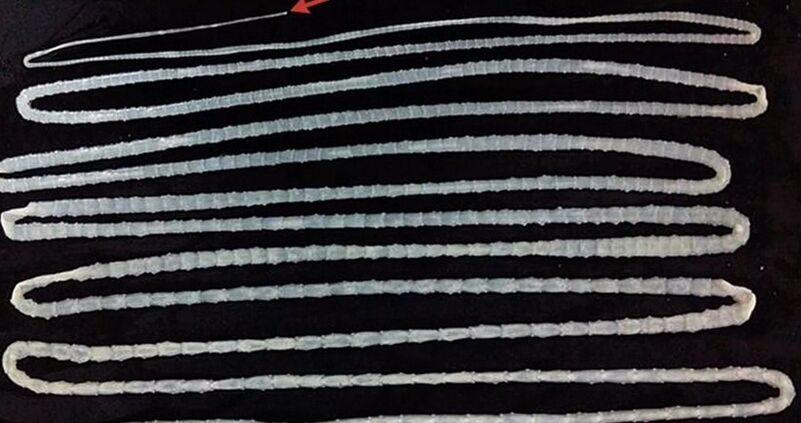
It lives only in the small intestine of an animal, a human. The intermediate host through which a person becomes infected is livestock. Infection occurs through raw or cooked meat, milk, or fish, poorly processed, or through contact with pets.
Hookworm: a harmful and dangerous worm
The worm is very common in East Asia, Africa, it causes hookworm. The parasite lives in the human duodenum, it does not grow, maximum 14 mm. The infection occurs through dirty hands, vegetables, fruits, even through the skin while working with the earth, when walking barefoot on the grass, the larvae penetrate the skin.
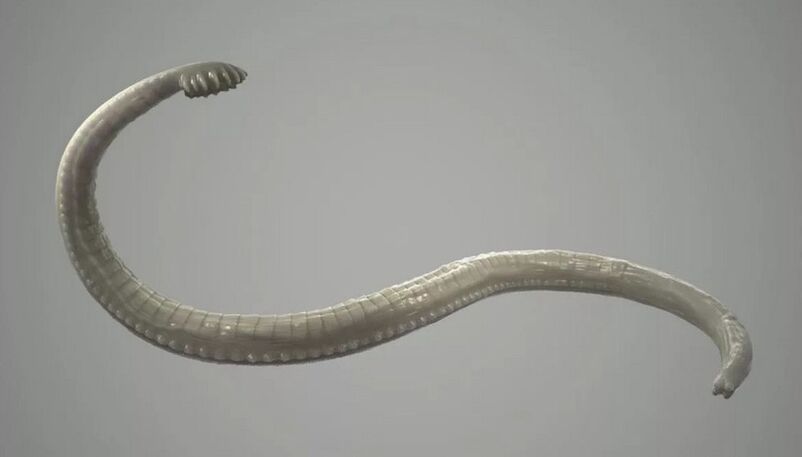
Once in the body, it enters the blood vessels, from there it goes to the liver, heart, lungs. Hookworm leads to serious complications, in particular hepatitis, ulcers.
Wide tape - a dangerous parasite with a large and long body
Infection with this worm occurs through fish, if a person ate raw, undercooked fish, raw pike caviar, or engaged in the processing of infected fish or shellfish.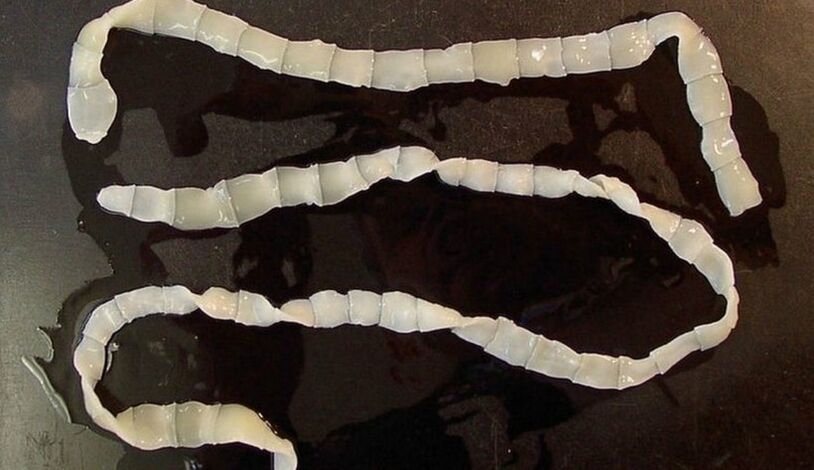 A dangerous tapeworm grows up to 15 meters in length, it is very large, the body consists of a large number of segments - up to 4, 000, on the head there are suction cups with which the worm attaches itself to the intestines. Looking at the photo of the worm, it is simply hard to believe that it can live inside a person. The larvae develop in just one month. Broad tapeworm leads to a serious disease - diphyllobothriasis.
A dangerous tapeworm grows up to 15 meters in length, it is very large, the body consists of a large number of segments - up to 4, 000, on the head there are suction cups with which the worm attaches itself to the intestines. Looking at the photo of the worm, it is simply hard to believe that it can live inside a person. The larvae develop in just one month. Broad tapeworm leads to a serious disease - diphyllobothriasis.
The patient is severely deficient in vitamins, because the worm feeds on all the nutrients in the body. Its entire large body absorbs substances on its surface. In the place where the tapeworm has been suctioned, necrosis begins. The most dangerous tapeworm can live on the human body for up to 10 years.
The pork tapeworm is a very harmful worm for the human body
This worm can be confused with a bovine tapeworm, but it does not grow that much, it measures a maximum of 3 meters. There are also fewer segments on the body, up to 1000. On the worm's head there are suckers, a proboscis with hooks. Therefore, the tapeworm sticks to the intestinal walls. It takes root in the body of pigs, rabbits, hares, dogs, camels, through which it reaches the person, the final owner. Infection is allowed by using raw bacon, meat. It is very dangerous for the eggs to enter the human body, as it becomes an intermediate master, in it the stage of the Finns occurs, which often leads to the most serious diseases and death.
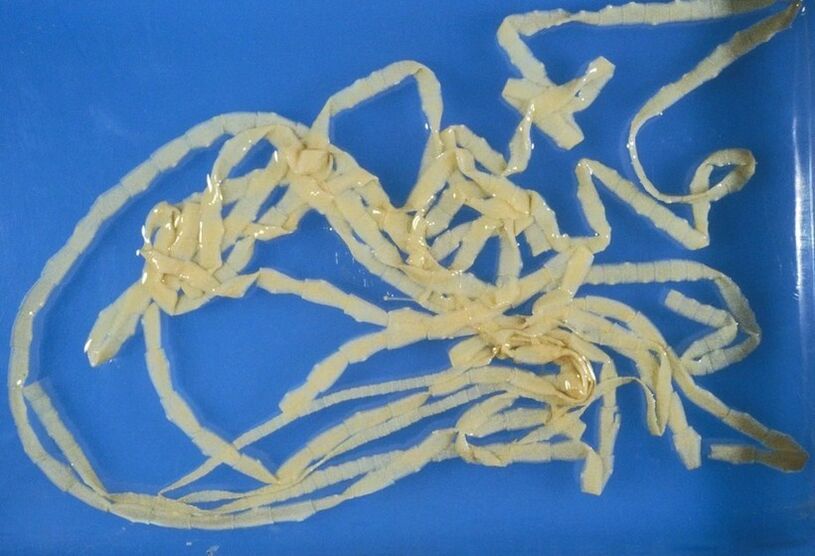
Helminths cause diseases of cysticercosis, taeniasis. If there are many parasites, they obstruct the intestines, as a result, the patient must be operated on urgently. They can pierce the intestinal walls, enter the lymphatic vessels and internal organs. Complications of ailments cause damage to the subcutaneous tissue, muscles, skin, spinal cord, brain, bones, and internal organs. The most important thing is to carry out prevention, carefully process meat before eating. A person should observe personal hygiene, the prevention of helminthiasis.






































